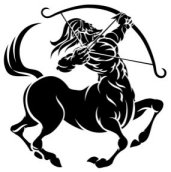
|
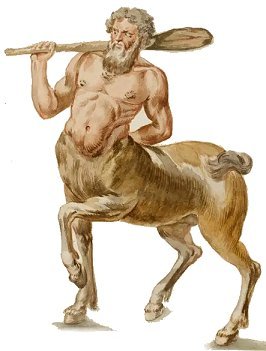
In the mountains and forests of
Thessaly lived a tribe of half-man, half-horse brutes called the
Centaurs (the Bull Killers). It is alleged that the cloud-nymph
Nephele was violated by the Lapith king called Ixion and she
gave birth to the beasts.
It is said that King Ixion fell in love with Hera, Queen of
Olympus and wife to Zeus. The foolish man tried to molest her, but
Hera managed to escape and told her husband about this
transgression.
Zeus was understandably livid and wanted to determine if Hera's
story was as she said. He fashioned a cloud (Nephele) and gave
it the form of Hera, laying it by Ixion's side. The lustful King
wasted no time in having his way with whom he thought was Hera.
But Ixion then was reckless and dumb enough to brag in public that he had
slept with the Queen of Olympus. That's all Zeus needed to hear.
He immediately punished Ixion by tying him to a wheel, forever spun by the
winds up in the air.
From Ixion's seed Nephele gave birth to the Centaurs. She then
delivered her brood on Mount Pelion, where they were nursed by
the daughters of the immortal Centaur Chiron.
Other sources relate that the Centaurs were the offspring of
Ixion mixing with his mares, or even that Zeus turned himself
into a horse and had relations with Deidameia, the wife of Ixion, who
then gave birth to the beasts.
This primitive race lived in caves and hunted wild animals for
food using tree branches and rocks as weapons. They were hybrid
creatures with the upper body of a man, from the head down to
the waist, and with the body and legs of a horse.
The Centaurs had the facial features of a normal man, but were
sometimes portrayed with a snub nose and pointed ears of a
Satyr.
They led rude and savage lives, covered in hair and ranging over
their mountains like wild animals, sometimes carrying off the
women of their neighbors.
They came to symbolize certain unsavory characteristics of
humankind, namely barbarism and unbridled chaos, more often than
not caused by their unrestrained fondness for wine.
But the Centaurs weren't all bad, often acting orderly and well
behaved - until they got into the wine, that is, at which point
they would be reduced to wild animals wreaking havoc.
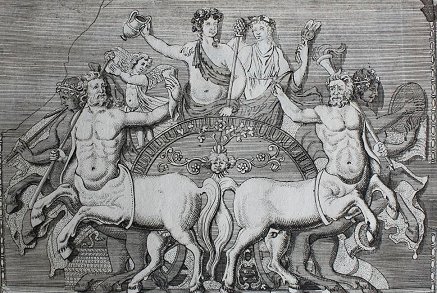
DRUNKEN FRACAS AT THE WEDDING
The Centaurs were notorious for their drunken behavior. At the
wedding of their half-brother named Pirithous and his betrothed
called Deidameia (or Hippodamia), they drank way too much
and tried to kidnap and molest the bride and other female guests.
A terrible battle ensued, in which most of the Centaurs were
killed or exiled by the Lapiths, as the natives were called.
The Lapiths were a tribe of Thessaly who were reputed to have
invented the horse bit and the circling course, and had been the
first men to ride horses, which were said to have been sired by
the Centaurs. The Lapiths also taught others to fight on
horseback in full armor, adding a deadly new innovation to
warfare.
The instigator of the wedding day melee was a rude Centaur named
Eurytion, who clouded his mind with the potent wine, became
frenzied and did monstrous things in the palace of Pirithous,
the gracious groom and host.
The outraged guests, including celebrated Theseus among other
heroes, dragged Eurytion across the courtyard and out of the
palace, lopping off his ears and nose as punishment. In the
fight that ensued many drunken Centaurs were slain.
The defeated remaining Centaurs made haste to leave the vicinity and
scurry to Arcadia. That was the beginning of the long and
hostile feud between men and Centaurs, called the Centauromachy.
One tribe of Centaurs lived on the island of Cyprus, and there
have been instances in classical art and literature where
beautiful female Centaurs, called Centaurides, were said to
exist.
These Centaurides were a wondrous sight to behold, some of them
attached to white mares, others to chestnut mares, while yet
others were dappled, glistening like champion stallions.
There was also a gorgeous white female Centaur that grew out of
a black mare, with the juxtaposition of the colors providing a
truly stunning beauty. All in all, the Centaurides were highly
admired.
A different tribe of Centaurs lived in the western Peloponnese.
Like most Centaurs, they reached maturity at the age of sixteen
and lived an average of sixty years.
There also existed Ichthyocentaurs (fish-centaurs), which were a
particular type of
Triton, the sea god. These fabulous beings had a human upper
part, with the lower part that of a fish. However, unlike
ordinary Tritons, instead of hands they had the lower
fore-quarters of a horse's feet.
The Icthyocentaurs' names were Aphros (sea-foam) and Bythos
(sea-depth). They were the sons of Cronus and Philyra, and
brothers of the famous Centaur
Chiron. Like
him they were regarded as wise teachers.
Their brows were crowned with a pair of lobster-claw horns.
Aphros is described as the first king of the sea-faring Aphroi
(Carthaginians). The two brother Icthyocentaurs were set in the
sky as the constellation Pisces.
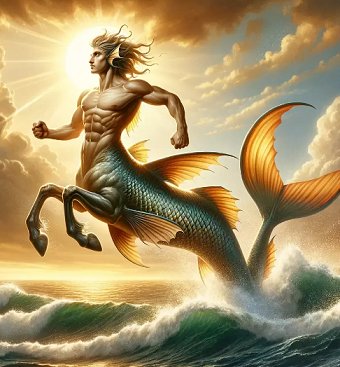
ICTHYOCENTAUR
by
Thatwitchsabrina
One suicidal Centaur named Nessus found fit to dare challenge
Heracles (Hercules), the greatest hero in ancient Greece.
Heracles arrived with his wife Deianeira at the river Evenus,
where Nessus had installed himself as ferryman.
When Deianira got on his back to cross the river, Nessus bolted,
taking the helpless woman with him. Heracles heard her screams
and raced to rescue his wife. In no time he managed to shoot the
Centaur in the heart with one of his arrows, which were dipped in
the blood of the Hydra, making them particularly lethal.
As Nessus lay dying he told Deianeira, as his final act of
malice, that his blood would ensure that Heracles would always
be faithful to her, knowing full well that his blood-soaked
tunic would itself be infected by
the Hydra's blood.
Deianeira stored away the bloody tunic but felt the need to
bring it out when she suspected Heracles was getting interested
in a maiden named Iole. She soaked a robe in the blood and
presented it to her husband, who was leaving for a meeting of
heroes.
Too late did Deianeira realize the ruse - she sent heralds to
warn Heracles, but they did not arrive in time. The hero lay
dying slowly and painfully as the robe burned his skin. He
finally died, but was then taken to Mount Olympus by Zeus and
joined the Pantheon of gods as a reward for his unsurpassed
heroic exploits.
In later times the Centaurs were drawn into the sphere of the
god of wine, Dionysus, shown pulling his chariot, or bound and
ridden by Eros, the god of love and assistant to goddess
Aphrodite.
This representation is an allusion to their drunken and amorous
habits, but in this context the Centaurs no longer appear as
savage and lawless beasts but rather tamed and harnessed by the
god of wine's power.
They were shown drawing the chariot of the god, and play the
horn or lyre, or they appear in the retinue of Dionysus mingling
with the ever-present Satyrs, Fauns, Nymphs and Bacchantes that
accompanied the god of wine everywhere.
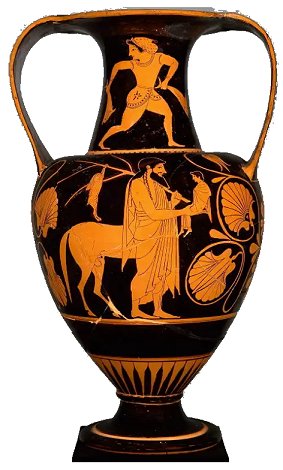
CHIRON & ACHILLES
The most famous, brilliant and
benevolent Centaur was Chiron, mentor and teacher to countless
Greek heroes and royalty.
Chiron was the son of the Titan Cronus and Philyra, who was an
Oceanid (Sea Nymph), who lived at the foot of Mount Pelion in
Thessaly. Philyra was so horrified by her offspring she begged
the gods for a way out of her situation. The gods transformed
her into a linden tree, leaving Chiron alone in Thessaly.
Unlike his violent and savage fellow Centaurs, Chiron was
renowned for his great wisdom and deep knowledge of medicine. He
was a mentor to numerous heroic luminaries, such as Heracles
(Hercules), Jason, Perseus and Achilles. Asclepius, beloved god
of Medicine, had been tutored by Chiron.
Chiron married a nymph named Charicio and they became parents of
Hippe, Endeis, Ocyrhoe and Carystus. Together with her mother in
law Philyria the Oceanid, Charicio was nurse to young Achilles.
When Heracles was doing battle with the Centaurs one of his
arrows accidently struck bystander Chiron. The wounded Centaur, because he
was immortal, could not die, yet he suffered a terrible
unbearable pain
daily.
Chiron couldn't heal himself because the poison of the Hydra, in
which Heracles' arrows had been dipped, was far too strong.
Prometheus the Titan, who had illegally given fire to humans,
had been sentenced by Zeus to be chained to a rock on Mount
Caucasus. Each day a huge eagle (or vulture) would swoop down
and feast on the chained Titan's liver, yet each night the liver
would regenerate, leading to an endless painful ordeal.
Heracles killed the eagle and freed Prometheus, then he offered
a solution to the Centaur's dilemma - If Chiron were to bestow
his immortality upon Prometheus, Zeus would let the Centaur die,
relieving him of his endless pain.
The deal was accepted by Chiron and the universally beloved
Centaur died in peace. To honor this outstanding mentor and
teacher, Zeus placed him in the heavens as the Centaurus
Constellation.
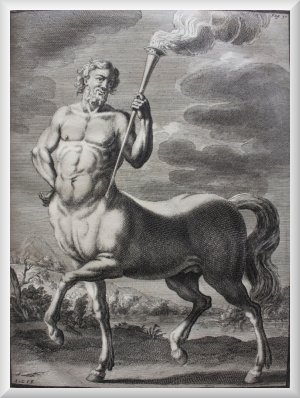
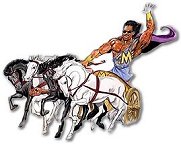
BACK HOME

|







